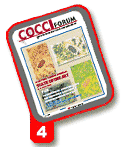COCCI FAQsSPAH's technical service team answers questions about managing coccidiosisQ. IS IT TRUE THAT THE USE OF THE COCCIDIOSIS VACCINE CAN RESTORE THE SENSITIVITY OF TRADITIONAL INFEED COCCIDIOSTATS?
A. Yes. In fact, when used over
time, the live oocyst vaccine actually
helps to convert resistant field strains to
strains that are more susceptible to traditional
in-feed coccidiostats. Q. IN TERMS OF MANAGEMENT, WHAT CAN I DO TO OPTIMIZE PERFORMANCE OF A COCCIDIOSIS VACCINE?
A. There are several steps that producers
can take to optimize the performance
of coccidiosis vaccination. Q. WHAT STEPS SHOULD BE TAKEN IN THE HATCHERY TO ENSURE BEST RESULTS WHEN ADMINISTERING A COCCIDIOSIS VACCINE?
For starters, always follow proper
vaccine mixing procedures. This
includes following the manufacturer’s
mixing chart for correct amount of distilled
water to vaccine, using the correct
amount of dye (so you can spot
any missed birds), and maintaining
constant mixing of vaccine while it’s
being sprayed. Visually inspect the
Carboy bottle to make sure the vaccine
is being stirred. Q. WHY DO COCCIDIOSIS VACCINES CONTAIN MORE THAN ONE SPECIES OF COCCIDIA?
A. Immunity to coccidia is species
specific. Therefore, immunity developed
against one species does not provide
cross protection against a different
species. For example, vaccinating or
exposing birds to only E. tenella over a
period of time will provide immunity or
protection only to further challenges
against E. tenella. In order to provide
broad protection against coccidiosis,
vaccines contain all the species considered
pathogenic to poultry. Q. MY HATCHERY PRODUCES BIRDS THAT ARE DESTINED FOR MORE THAN ONE COMPLEX. IF I VACCINATE BIRDS FOR ONE COMPLEX, IS THERE A DANGER OF EXPOSING THE BIRDS DESTINED FOR THE OTHER COMPLEX WITH COCCIDIA FROM THE VACCINE?
A. There is no danger of creating a
problem with cross-contamination at
the hatchery. The complex not using a
coccidiosis vaccine will be using a coccidiostat
for coccidiosis control. Live
vaccine oocysts are highly sensitive to
anticoccidials, so even if 1-day-old
chicks are exposed to a full dose of the
vaccine by accident, the vaccine will be
eliminated by the coccidiostat in the
starter feed. Q. DO I HAVE TO ROTATE COCCIDIOSIS VACCINES WITH ANTICOCCIDIALS?
A. No. Vaccines can provide yearround
protection without the buildup
of resistance associated with anticoccidials.
In broilers, some companies
choose to rotate the vaccine and anticoccidials
— perhaps three cycles with
vaccine, two with a coccidiostat — due
to cost (small birds) or to field-management
conditions that make vaccine
reactions more difficult to control in
cold weather. Q. CAN COCCIDIOSIS VACCINE BE USED IN WINTER?
A. Yes. Coccidiosis vaccine can be
used in any season as long as moderately
dry litter conditions can be maintained
and stocking density can be
managed to control the vaccination
reaction. Some companies find it difficult
to use coccidiosis vaccine in winter
because ventilation is reduced and
birds are held in the partial house
longer than 14 days.
|




 © 2000 - 2021. Global Ag MediaNinguna parte de este sitio puede ser reproducida sin previa autorización.
© 2000 - 2021. Global Ag MediaNinguna parte de este sitio puede ser reproducida sin previa autorización.